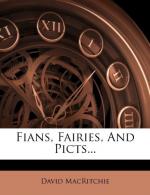Produced by Ted Garvin, Taavi Kalju, and the Online Distributed Proofreaders Europe at http://dp.rastko.net
[Illustration: Plate I.
Selectional view and ground plan of underground gallery, called UAMH SGALABHAD, near MOL A Deas, Huishnish, island of south Uist.
Frontispiece.]
Fians, fairies
and
picts
BY
DAVID MACRITCHIE
Author of
“The testimony of tradition”
“Sometimes ... it seems that the stones are really speaking—speaking of the old things, of the time when the strange fishes and animals lived that are turned into stone now, and the lakes were here; and then of the time when the little Bushmen lived here, so small and so ugly, and used to sleep in the wild dog holes, and in the ‘sloots,’ and eat snakes, and shoot the bucks with their poisoned arrows ... Now the Boers have shot them all, so that we never see a little yellow face peeping out among the stones ... And the wild bucks have gone, and those days, and we are here.”—Waldo, in The Story of an African Farm.
WITH ILLUSTRATIONS
London
Kegan Paul, Trench, TRUeBNER & Co.,
Ltd.
Paternoster house, Charing Cross
road
1893
INTRODUCTION.
The following treatise is to some extent a re-statement and partly an amplification of a theory I have elsewhere advanced.[1] But as that theory, although it has been advocated by several writers, especially during the past half-century, is not familiar to everybody, some remarks of an explanatory nature are necessary. And if this explanation assumes a narrative form, not without a tinge of autobiography, it is because this seems the most convenient way of stating the case.
It is now a dozen years or thereabouts since I first read the “Popular Tales of the West Highlands,” by Mr. J.F. Campbell, otherwise known by his courtesy-title of “Campbell of Islay.” Mr. Campbell was, as many people know, a Highland gentleman of good family, who devoted much of his time to collecting and studying the oral traditions of his own district and of many lands. His equipment as a student of West Highland folklore was unique. He had the necessary knowledge of Gaelic, the hereditary connection with the district which made him at home with the poorest peasant, and the sympathetic nature which proved a master-key in opening the storehouse of inherited belief. It is not likely that another Campbell of Islay will arise, and, indeed, in these days of decaying tradition, he would be born too late.




